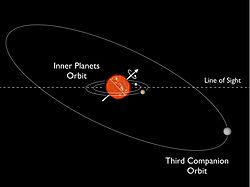astro.wikisort.org - Star
Kepler-56 is a red giant[6] in constellation Cygnus roughly 3,060 light-years (940 pc) away[4] with slightly more mass than the Sun.
 Graphical sketch of the Kepler-56 system. The line of sight from Earth is illustrated by the dashed line, and dotted lines show the orbits of three detected companions in the system. The solid arrow marks the rotation axis of the host star, and the thin solid line marks the host star equator. Credit: NASA GSFC/Ames/D Huber | |
| Observation data Epoch J2000.0[1] Equinox J2000.0[1] | |
|---|---|
| Constellation | Cygnus |
| Right ascension | 19h 35m 02.0014s[4] |
| Declination | +41° 52′ 18.692″[4] |
| Apparent magnitude (V) | 13 |
| Characteristics | |
| Evolutionary stage | red giant[5] |
| Spectral type | K |
| Astrometry | |
| Proper motion (μ) | RA: −6.746±0.044[4] mas/yr Dec.: −12.025±0.043[4] mas/yr |
| Parallax (π) | 1.0673 ± 0.0280 mas[4] |
| Distance | 3,060 ± 80 ly (940 ± 20 pc) |
| Details[5] | |
| Mass | 1.286±0.011 M☉ |
| Radius | 4.179±0.132 R☉ |
| Luminosity (bolometric) | 9.589±0.129 L☉ |
| Temperature | 4973±14 K |
| Age | 3.917±0.157 Gyr |
| Other designations | |
| Database references | |
| SIMBAD | data |
| Extrasolar Planets Encyclopaedia | data |
Planetary system
In 2012, scientists discovered a 2-planet planetary system around Kepler-56 via the transit method. Asteroseismological studies revealed that the orbits of Kepler-56b and Kepler-56c are coplanar but about 45° misaligned to the host star's equator. In addition, follow-up radial velocity measurements showed evidence of a gravitational perturbator.[6] It was confirmed in 2016 the perturbations are caused by third, non-transiting planet.[7]
The planetary system is very compact but is dynamically stable.[8]
The expanding star will devour Kepler-56b and Kepler-56c in 130 and 155 million years, respectively.[9][10]
| Companion (in order from star) |
Mass | Semimajor axis (AU) |
Orbital period (days) |
Eccentricity | Inclination | Radius |
|---|---|---|---|---|---|---|
| b[2][11] | 0.07 MJ | 0.1028 | 10.5034294 | — | 79.640° | 3.606495320 R🜨 |
| c[3][12] | 0.569 MJ | 0.1652 | 21.4050484 | — | 81.930° | 7.844702558 R🜨 |
| d[7] | >5.61±0.38 MJ | 2.16±0.08 | 1002±5 | 0.20±0.01 | — | — |
References
- "Kepler-56". SIMBAD. Centre de données astronomiques de Strasbourg.
- "Planet Kepler-56 b". The Extrasolar Planets Encyclopaedia. Retrieved 2013-10-18.
- "Planet Kepler-56 c". The Extrasolar Planets Encyclopaedia.
- Brown, A. G. A.; et al. (Gaia collaboration) (August 2018). "Gaia Data Release 2: Summary of the contents and survey properties". Astronomy & Astrophysics. 616. A1. arXiv:1804.09365. Bibcode:2018A&A...616A...1G. doi:10.1051/0004-6361/201833051. Gaia DR2 record for this source at VizieR.
- Fellay, L.; Buldgen, G.; et al. (October 22, 2021). "Asteroseismology of evolved stars to constrain the internal transport of angular momentum". Astronomy & Astrophysics. 654. 12. arXiv:2108.02670. doi:10.1051/0004-6361/202140518. S2CID 239652877. Retrieved March 30, 2022.
- Huber, Daniel; Carter, Joshua; et al. (October 21, 2013). "Stellar Spin-Orbit Misalignment in a Multiplanet System". Science. 342 (6156): 331–334. arXiv:1310.4503. Bibcode:2013Sci...342..331H. doi:10.1126/science.1242066. PMID 24136961. S2CID 1056370.
- THE ORBIT AND MASS OF THE THIRD PLANET IN THE KEPLER-56 SYSTEM, 2016, arXiv:1608.03627
- HIDDEN PLANETARY FRIENDS: ON THE STABILITY OF 2-PLANET SYSTEMS IN THE PRESENCE OF A DISTANT, INCLINED COMPANION, 2018, arXiv:1802.00447
- Kramer, Miriam (June 10, 2014). "Chow Down! Star Will Devour 2 Alien Planets". Space.com. Retrieved 24 February 2022.
- Li, Gongjie; Naoz, Smadar; et al. (October 1, 2014). "The Dynamics of the Multi-planet System Orbiting Kepler-56". The Astrophysical Journal. 794 (2): 131. arXiv:1407.2249. Bibcode:2014ApJ...794..131L. doi:10.1088/0004-637X/794/2/131. S2CID 56224888.
- "KOI-1241.02 -- Extra-solar Confirmed Planet". SIMBAD.
- "KOI-1241.01 -- Extra-solar Confirmed Planet". SIMBAD.
External links
На других языках
- [en] Kepler-56
[ru] Kepler-56
Kepler-56 — звезда в созвездии Лебедя,находится на расстоянии около 2011 световых лет от Солнца. Вокруг звезды обращаются, как минимум, две планеты.Текст в блоке "Читать" взят с сайта "Википедия" и доступен по лицензии Creative Commons Attribution-ShareAlike; в отдельных случаях могут действовать дополнительные условия.
Другой контент может иметь иную лицензию. Перед использованием материалов сайта WikiSort.org внимательно изучите правила лицензирования конкретных элементов наполнения сайта.
Другой контент может иметь иную лицензию. Перед использованием материалов сайта WikiSort.org внимательно изучите правила лицензирования конкретных элементов наполнения сайта.
2019-2025
WikiSort.org - проект по пересортировке и дополнению контента Википедии
WikiSort.org - проект по пересортировке и дополнению контента Википедии


